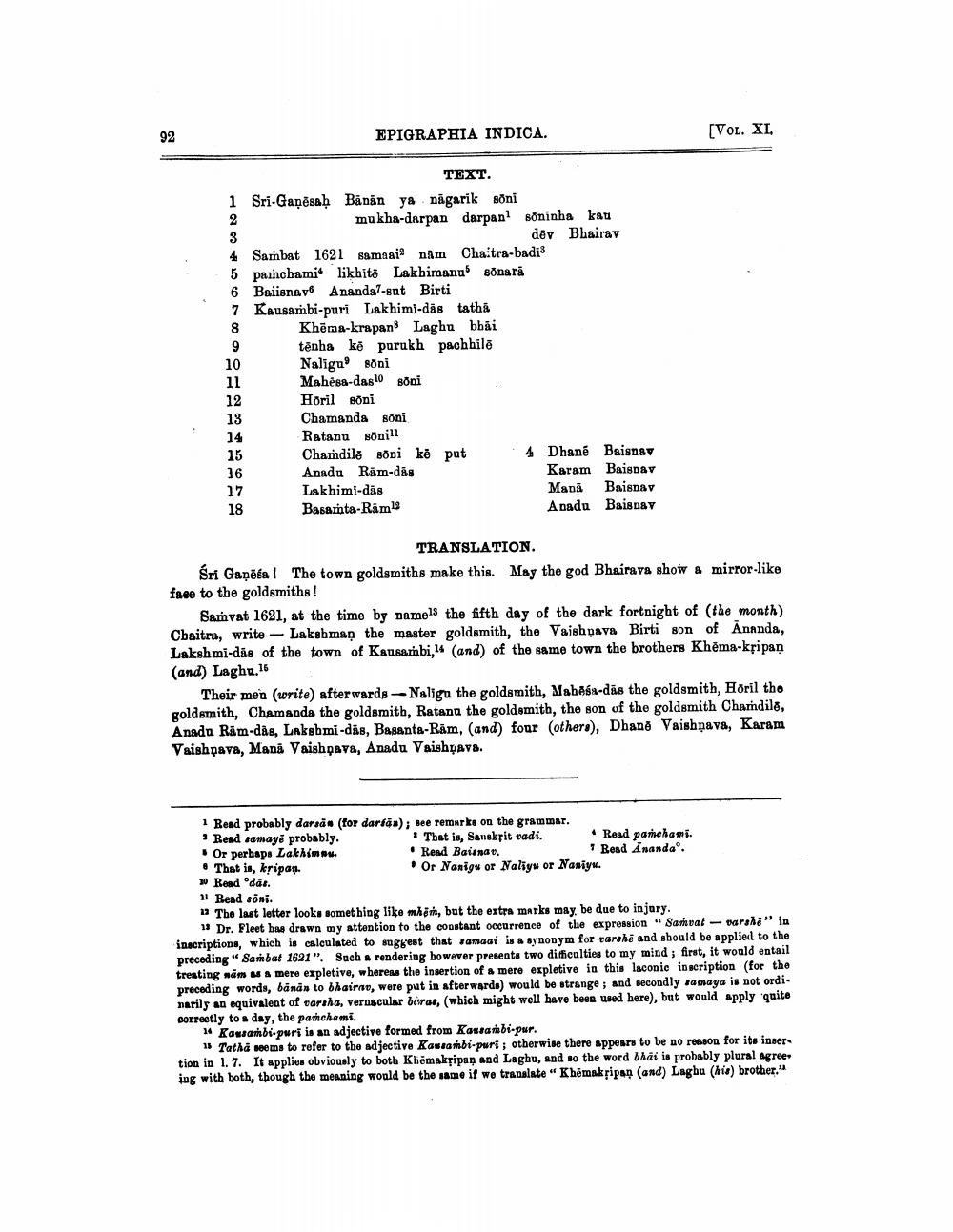________________
EPIGRAPHIA INDICA.
[Vol. XI.
TEXT. 1 Sri-Gaņēsaḥ Banán ya nagarik sõni mukha-darpan darpan söninha kau
dēv Bhairav 4 Sambat 1621 samaai nim Chaitra-badi: 5 panchamit likhitó Lakbimana sðnară 6 Baiisnav Ananda-sat Birti 7 Kausambi-puri Lakhimi-däs tatha
Khēma-krapanS Laghubbãi tenha ko parukh pachhilē Naligno Boni Mahesa-das0 Bðni Horil soni Chamanda soni Ratanu sonill Chamdile Boni kē put .4 Dhané Baisnav Anadu Räm-dás
Karam Baisnav Lakhimi-dās
Mani Baisnav Basanta-Ram
Apadu Baisney
TRANSLATION. Sri Gaņēka! The town goldsmiths make this. May the god Bhairava show a mirror-like face to the goldsmiths!
Samvat 1621, at the time by names the fifth day of the dark fortnight of the month) Chaitra, write - Lakshman the master goldsmith, the Vaishpava Birti son of Ananda, Lakshmi-dãs of the town of Kausambi, (and) of the same town the brothers Khēma-ksipan (and) Laghu. 16
Their men (write) afterwards --Naligu the goldsmith, Mahasa-das the goldsmith, Horil tho goldsmith, Chamanda the goldsmith, Ratana the goldsmith, the son of the goldsmith Chamdile, Anadu Räm-dås, Lakshmi-dås, Basanta-Ram, (and) four othero), Dhano Vaishnava, Karam Vaishpava, Mana Vaishpava, Anadu Vaishqava.
Rend probably darske (for darfax); see remarks on the grammar. • Bendramay probably.
. That is, Sanskrit radi. Read panchami. Or perhaps Lakhimou.
. Read Baiende.
* Read Ananda • That is, kripan.
• Or Nanigu or Naliyw or Naniyu. 30 Read odas. 1 Bead soni.
The last letter looks something like man, but the extra marks may be due to injury. 1 Dr. Fleet has drawn my attention to the constant occurrence of the expression “Samvat - warsha" in inscriptions, which is calculated to suggest that samaai is a synonym for rarthi and should be applieil to the preceding " Sambat 1621". Such a rendering however presents two difficulties to my mind; first, it would entail treating nam ma mere expletive, whereas the insertion of a mere expletive in this laconic inscription (for the preceding words, banan to bhairne, were put in afterwards) would be strange ; and secondly samaya is not ordi. marily ao equivalent of rartha, vernacular boras, (which might well have been used here), but would apply quite correctly to a day, the panchami.
# Kawambi-puri is an adjective formed from Kausambi-pur.
15 Tatha seems to refer to the adjective Kaucambi-puri; otherwise there appears to be no reason for its inser tion in 1. 7. It applies obviously to both Kliēmakripan and Laghu, and so the word bhai is probably plural agree ing with both, though the meaning would be the same if we translate "Khemskripan (and) Laghu (his) brother."




